Belated postcard from Sao Paulo.
 Image courtesy of FILE festival
Image courtesy of FILE festival
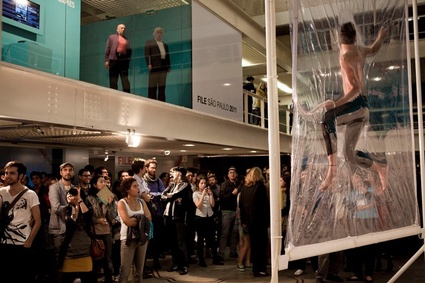
If you happen to be in or around Sao Paulo this Summer (or Winter, i was told it is Winter over here but super sunny and 25 degrees Celsius is no credible Winter to me) don’t miss FILE, the Electronic Language International Festival that takes place at the FIESP Cultural Center and all over the Avenida Paulista till late August. And because FILE makes it its duty to attract the general public and not just the art&tech aficionados, the event is not only free but also packed with surprising installations, games, videos and events.
Here’s a quick look at what the festival has in store! Part one, the installations!
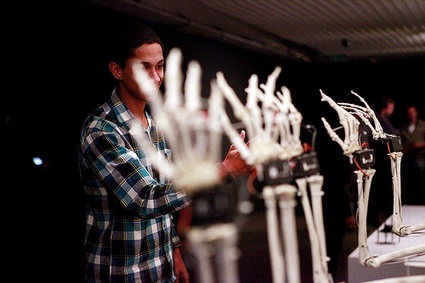 Hye Yeon Nam, Please Smile. Photo Julia Moraes
Hye Yeon Nam, Please Smile. Photo Julia Moraes
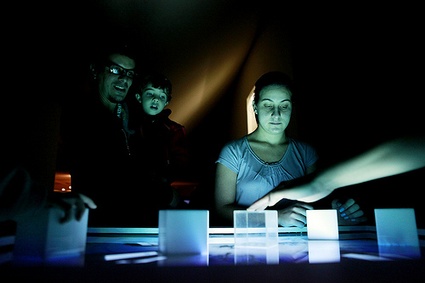 Joon Y. Moon, Augmented Shadow. Photo Julia Moraes
Joon Y. Moon, Augmented Shadow. Photo Julia Moraes
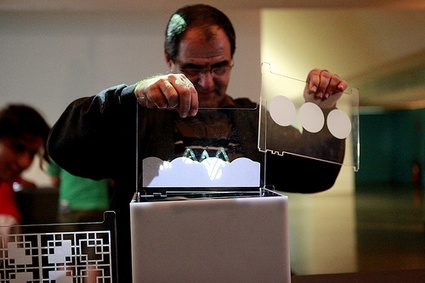 Kimchi & Chips, Journey Seoul. Photo Julia Moraes
Kimchi & Chips, Journey Seoul. Photo Julia Moraes
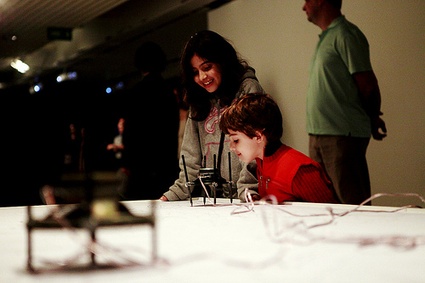 Lars Lundehave Hansen, Spiderbytes. Photo Julia Moraes
Lars Lundehave Hansen, Spiderbytes. Photo Julia Moraes
A new addition to the festival programme, FILE Tablet allows visitors to test and play with artistic applications on iPads:
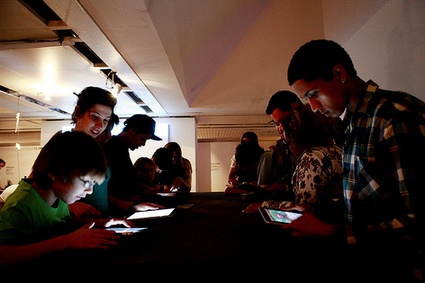 Photo Julia Moraes
Photo Julia Moraes
And if ever you were wondering which works i found the most interesting (or downright disquieting):
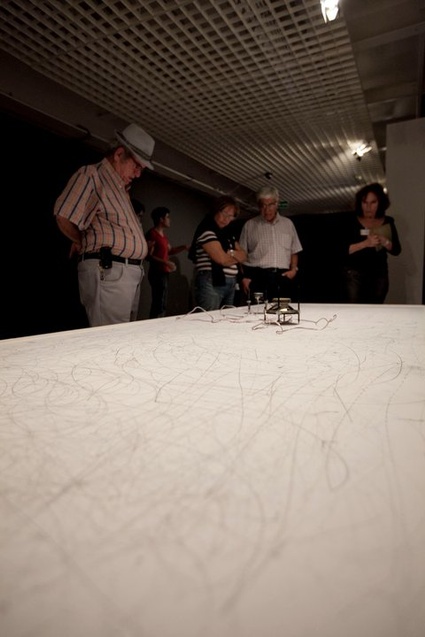 Lars Lundehave Hansen, Spiderbytes. Image courtesy of FILE festival
Lars Lundehave Hansen, Spiderbytes. Image courtesy of FILE festival
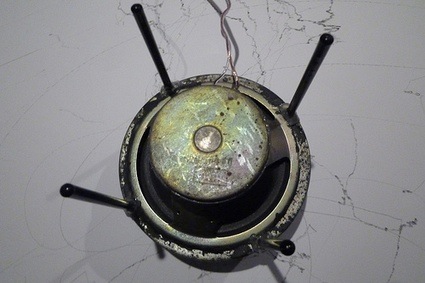 Lars Lundehave Hansen, Spiderbytes (detail)
Lars Lundehave Hansen, Spiderbytes (detail)
Spiderbytes, by Lars Lundehave Hansen, uses small clunky creatures to visualize sound. The spiders, made of speaker units mounted with graphite sticks and animated by low frequencies from 5 Hz to 50 Hz, imprint their marks on a white surface depending on the sound fed to them.
A smart twist on the classic drawing robots.
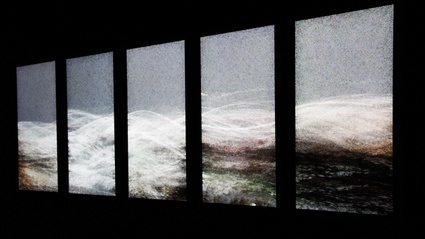 Ryoichi Kurokawa, Rheo: 5 horizons. Installation view. Photo by JMAF
Ryoichi Kurokawa, Rheo: 5 horizons. Installation view. Photo by JMAF
The most mind-blowing work for me was Ryoichi Kurokawa‘s Rheo: 5 horizons, a 5 screen audiovisual installation in which each vertically long imagery pairs with each mono channel sound, and each video is synchronized to each audio. These juxtaposed resonances have an impact on sensory perception, which develops a similar synesthetic experience.
The title quite fittingly derives from the expression of Greek philosopher Heraclitus of Ephesus “panta rhei”, which means “everything is in a state of flux”. If you want to know more about it, the blurb is over here but i didn’t need it to be won over by the piece. Not sure the video will convey much of its
But somehow, i felt that the winners of this edition of FILE were the works showing little or no technology. I already mentioned ADA – analog interactive installation but there were more surprises in store. Such as Shrink, Lawrence Malstaf’s dependable crowd-pleaser…
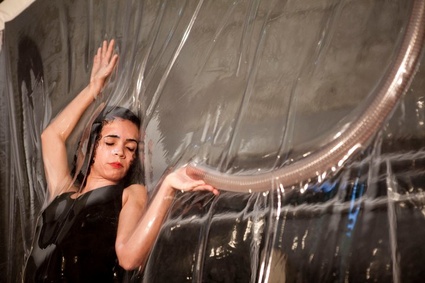 Lawrence Malstaf, Shrink. Image courtesy of FILE festival
Lawrence Malstaf, Shrink. Image courtesy of FILE festival
Or the irresistible Máquina/brinquedo. A pinball machine made by the Collective COLETORES using discarded materials: wood, rubber and some human propulsion.
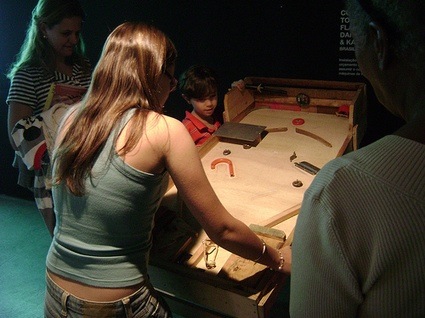 Collective COLETORES, Máquina/brinquedo. Image Collective COLETORES
Collective COLETORES, Máquina/brinquedo. Image Collective COLETORES
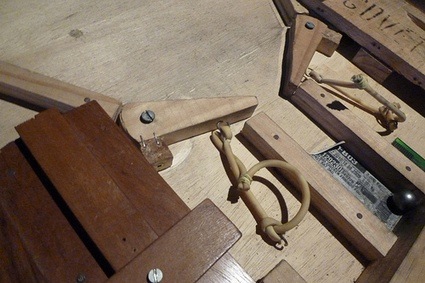 Collective COLETORES, Máquina/brinquedo (detail)
Collective COLETORES, Máquina/brinquedo (detail)
Other works which might be of interest:
The Happy Cube, by Julian Jaramillo, is happy because it doesn’t need any wire nor connection to a laptop to play music. Flipping the cube on one if its sides triggers a musical generative process which mixes both random tunes and sound material previously composed.
Ijiro “the robot which expresses emotions reacting to a user’s actions” made me rather uncomfortable. Ijiro isn’t able to move itself because it doesn’t have any actuators. It’s just the face of a man stuck inside what looks like a tiny version of a can of Pringle’s. It does look alive and its/his face starts smiling, sulking or displays other types of emotions as someone who doesn’t have the misfortune of being trapped inside a can of potato chips touches it, or makes the tube lie, stand, swings it, if you make it roll or hang it. He can even talk but I felt sorry for him/it, really.
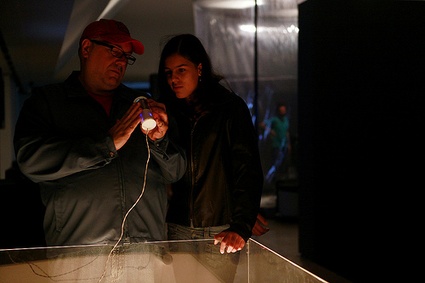 Kazushi Mukaiyama and Yujiro Kabutoya, IjiroPhoto Julia Moraes
Kazushi Mukaiyama and Yujiro Kabutoya, IjiroPhoto Julia Moraes
Its creators, Kazushi Mukaiyama and Yujiro Kabutoya, developed Ijiro as a physical pet to entertain people.
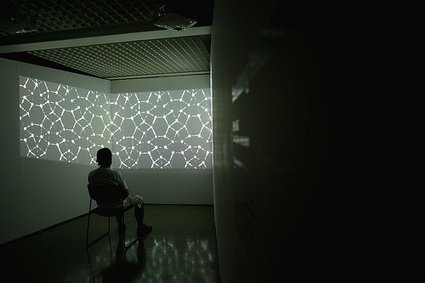 Ben Jack, Elucidating Feedback. Photo Julia Moraes
Ben Jack, Elucidating Feedback. Photo Julia Moraes
Elucidating Feedback, by young media artist Ben Jack, is a brain-controlled installation. The brain-computer interface reads your brainwaves and this alters how the installation creates form from static. The more attention is paid, the more pattern is formed; as less attention is paid, the pattern breaks back into static.
And a last one for the road…
Yoshi Akai‘s Heart ‘n’ Beat is a musical instrument for three players. Insert the index inside a small leather ring and the instrumnet will take your pulse and use it as the basis for a tune. You can then add sound samples and play along to your own heart.
Seemed to work like a charm for everyone. Alas for me, i appeared to have no heart beat.
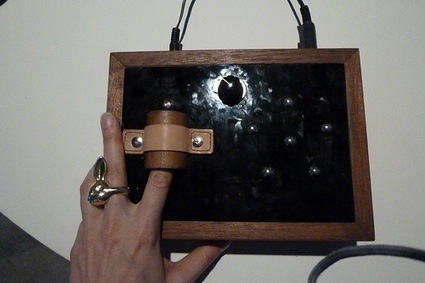 Yoshi Akai, Heart ‘n’ Beat
Yoshi Akai, Heart ‘n’ Beat
Also part of the exhibition: ADA – analog interactive installation.
More images on my flickr set.
FILE, the Electronic Language International Festival remains open through August 21, 2011, at the FIESP Cultural Center – Ruth Cardoso, in Sao Paulo, Brazil. Entrance is free.
